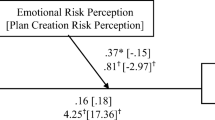Abstract
Background
ParticipACTION’s Think Again campaign targeted mothers who think their children are sufficiently active, yet whose children do not achieve recommended amounts of physical activity.
Purpose
This research examined the relationship of mothers’ intentions to support children’s physical activity with explicit believability and implicit agreement with the Think Again campaign message, attention paid to the advertisement, involvement with the issue, concern regarding children’s inactivity, and attitudes.
Method
Participants were mothers from Edmonton, Canada (N = 102) who viewed one Think Again advertisement then completed a measure of implicit agreement with the campaign message and questionnaires.
Results
The mothers who paid attention to the message and were concerned for their own children were more likely to intend to act on campaign messages. The majority of participants implicitly agreed that children’s physical inactivity was a problem, but there was less agreement that physical inactivity was a problem for their own children.
Conclusion
Participants automatically tended to agree with campaign messages when the focus was on children in general, but there was greater disagreement when asked about participant’s own children. Why most mothers were not in agreement with the reality of how much physical activity their children needs remains to be determined.

Similar content being viewed by others

References
Colley RC, Garriguet D, Janssen I, Craig CL, Clarke J, Tremblay MS. Physical activity of Canadian children and youth: accelerometer results from the 2007 to 2009 Canadian Health Measures Survey. Health Rep. 2011;22:15–24. http://www.statcan.gc.ca/pub/82-003-x/2011001/article/11397-eng.htm. Accessed 10 May 2012.
Centers for Disease Control and Prevention. Youth risk behavior surveillance. Morb Mortal Wkly Rep. 2006;55(No. SS-5). http://www.cdc.gov/mmwr/pdf/ss/ss5505.pdf. Accessed 10 May 2012.
Huhman ME, Potter LD, Nolin MJ, Piesse A, Judkins DR, Banspach SW, Wong FL. The influence of the VERB campaign on children’s physical activity in 2002 to 2006. Am J Public Health. 2010;100:638–45.
Trost SG, Sallis JF, Pate RR, Freedson PS, Taylor WC, Dowda M. Evaluating a model of parental influence on youth physical activity. Am J Prev Med. 2003;25:277–82.
Gustafson S, Rhodes RE. Parental correlates of child and early adolescent physical activity: a review. Sports Med. 2006;36:79–97.
Price SM, Huhman M, Potter LD. Influencing the parents of children aged 9–13 years: findings from the VERB campaign. Am J Prev Med. 2008;34:S267–74.
Craig CL, Bauman A, Gauvin L, Robertson J, Murumets K. ParticipACTION: a mass media campaign targeting parents of inactive children; knowledge, saliency, and trialing behaviors. Int J Behav Nutr Phy. 2009. doi:10.1186/1479-5868-6-88.
Bauman A, Smith BJ, Maibach EW, Reger-Nash B. Evaluation of mass media campaigns for physical activity. Eval Program Plann. 2006;29:312–22.
Cameron C, Craig CL, Bull FC, Bauman AE. Canada’s physical activity guides: has their release had an impact? Appl Physiol Nutr Metab. 2007;32:S161–9.
Craig CL, Bauman AE, Reger-Nash B. Testing the hierarchy of effects model: ParticipACTION’s serial mass communication campaigns on physical activity in Canada. Health Promot Int. 2009;5:14–23.
Spence JC, Brawley L, Craig CL, Plotnikoff RC, Tremblay M, Bauman A, Faulkner G, Chad K, Clark MI. Awareness of the ParticipACTION campaign among Canadian adults: examining the knowledge gap hypothesis and a hierarchy-of-effects model. Int J Behav Nutr Phy. 2009;6:85. doi:10.1186/1479-5868-6-85.
O’Cass A, Griffin D. Antecedents and consequences of social issue advertising believability. J Nonprofit Public Sect Mark. 2006;15:87–104.
Berry TR, Jones KE, McLeod NC, Spence JC. The relationship between implicit and explicit believability of exercise-related messages and intentions. Health Psychol. 2011;30:746–52.
Huang Y, Hutchinson JW. Counting every thought: implicit measures of cognitive responses to advertising. J Cons Res. 2008;35:98–118.
Petty RE, Priester JR, Brinol P. Mass media attitude change: Implications of the elaboration likelihood model of persuasion. In: Bryant J, Zillmann D, editors. Media effects: Advances in theory and research. Mahwah: Lawrence Erlbaum Associates; 2002. p. 155–89.
Fazio RH, Olson MA. Implicit measures in social cognition research: their meaning and use. Annu Rev Psychol. 2003;54:297–327.
The active healthy kids Canada report card on physical activity for children and youth. 2009. http://dvqdas9jty7g6.cloudfront.net/reportcard2009/ahkc-longform_web_final.pdf. Accessed 10 May 2012.
Tremblay MS, Warburton DER, Janssen I, Paterson DH, Latimer AE, Rhodes RE. New Canadian physical activity guidelines. Appl Physiol Nutr Met. 2011;36:36–46.
Schneider W, Eschman A, Zuccolotto A. E–Prime user’s guide. Pittsburgh: Psychology Software Tools; 2002.
Beltramini RF. Perceived believability of warning label information presented in cigarette advertising. J Advertising. 1988;17:26–32.
Laczniak RN, Muehling DD, Grossbart S. Manipulating message involvement in advertising research. J Advertising. 1989;18:28–38.
Zaichowsky JL. Measuring the involvement construct. J Consum Res. 1985;12:341–52.
Festinger L. A theory of cognitive dissonance. Stanford: Stanford University Press; 1957.
Casiro N, Rhodes RE, Naylor PJ, McKay HA. Correlates of intergenerational and personal physical activity of parents. Am J Health Behav. 2011;35:81–91.
Braver MCW, Braver SL. Statistical treatment of the Solomon four-group design: a meta-analytic approach. Psych Bull. 1988;104:150–4.
Acknowledgments
This research was undertaken, in part, with support given to Tanya R. Berry from the Canada Research Chairs program and Alberta Innovates – Health Solutions.
Author information
Authors and Affiliations
Corresponding author
Rights and permissions
About this article
Cite this article
Berry, T.R., Craig, C.L., Faulkner, G. et al. Mothers’ Intentions to Support Children’s Physical Activity Related to Attention and Implicit Agreement with Advertisements. Int.J. Behav. Med. 21, 131–138 (2014). https://doi.org/10.1007/s12529-012-9279-5
Published:
Issue Date:
DOI: https://doi.org/10.1007/s12529-012-9279-5



